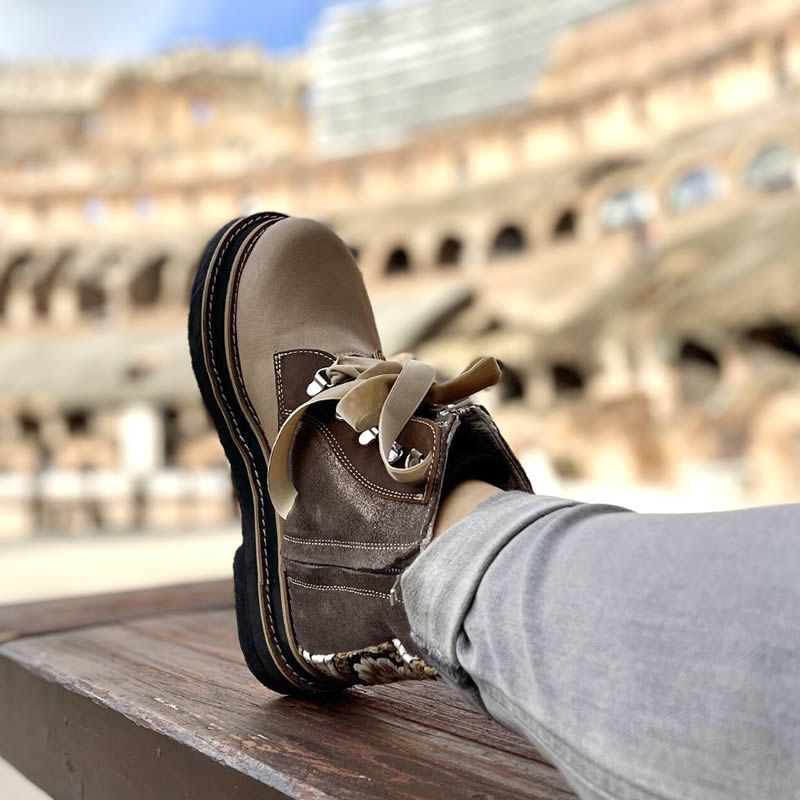
There isn’t a single woman who doesn’t have a good pair of boots in her closet to wear on any occasion.
And very often, we don't settle for only one pair…
We have a pair for cold days, another to wear with a nice dress, another that goes best with jeans or an informal outfit, another that is ideal for walking and discovering new places, some with heels, others with chunky soles, a pair of combat boots… In summary, there is no limit to the number of boots a woman can have and the use she can have for them.
But it is very likely that we have never thought about how long women have been using this type of footwear and how it originated.
To begin with, we can tell you that leather boots were already being worn 15,000 years ago and therefore it is correct to state that boots as a type of footwear have already come a long way throughout history.
It’s worth keeping in mind, however, that it is very likely that the boots worn 15,000 years ago had very little to do with those we currently see in stores and on fashion catwalks; but without a doubt, they had in some aspects the same objective: to protect our feet and protect us from the cold and humidity. There are numerous cave paintings, especially in Spain, where both men and women of that time are shown wearing boots. From there we can deduce that since that time, boots were considered a type of unisex footwear.
On the other hand, vestiges of boots have also been discovered in Mesopotamia and the Middle East, where they not only served a useful purpose, but also aesthetic and fashion. At this time, toe caps were decorated giving them a luxury item status.
Later, boots were considered an article of exclusively masculine use; since it was men who traditionally rode horses and went out to the fields to work while women stayed at home. Only in the highest social classes were women granted the right to ride a horse, and to do so, they wore a pair of suitable boots.
The 19th century was a time of change and modernity in many aspects
Including a new attitude in women, now more curious and willing to leave their homes to see the world. Thus, around 1830, women began to wear very feminine boots, with delicate and refined models, and low height; very different from those that men used to work, whether for military reasons or as a simple fashion element. At this time, women’s boots were decorated with bows, buttons and inlays; so they were considered a sophisticated and elegant item.
But, curiously, it was Queen Victoria, known for her conservative attitude, who around the year 1840 made women’s boots of this style fashionable. She asked her personal shoemaker, J. Sparkes Hall, to make a model of a boot that came to be known as the “Balmoral boot”, with the idea of being able to take long walks through the well-known Scottish castle that bears that name; this was the Queen’s favourite.
The Balmoral boot was a decorated boot that covered the entire ankle and had a very wide sole, designed especially for long walks. Little by little, this type of boot entered the daily life of women belonging to the nobility of that time, being worn at big parties and adding much more striking and sumptuous decorations. At first they were exclusively made of leather, but soon other materials such as silk and taffeta began to be used.
Around the second half of the 19th century
The boot was already the commonly used footwear by men and women, both in summer and winter; and the models began to diversify. Approximately in 1870, the first high boots for women appear, which until that date was something reserved for men’s boots. There was also a proliferation in ankle boots among the lower classes, thanks to mass production.
Despite these changes, at the beginning of the 20th century, the “walk” and “party” boots, so popular in the last decades of the previous century, were no longer used; and the boots regain their status as a work tool. And with few exceptions, they maintained that status until the 50’s, when they entered the world of fashion again.
The continuous advance in the means of transport made it possible for fashion to “travel” much faster between continents, and for leather boots, worn mainly in the central parts of Europe, to begin to appear in the rest of the world as fashionable footwear, filling them with new decorative elements, and sometimes raising their height to the thigh.
The youth of the 1960s and 1970s used boots as a symbol and emblem of their freedom movement. Leather became a canvas for multicolored psychedelic designs, and other materials such as plastic and vinyl began to be used, also becoming fashion icons of the time. Never before has there been such a variety of styles, colors, lengths, heel heights and decorations.
During the 1980s, the craze for boots continued to grow, led by cowboy boots, which had always been marginalized due to their small public and their craftsmanship. At this time a fashion developed that placed the cowboy boot on the streets and catwalks around the world.
Today there are a thousand ways to wear boots. We can find the perfect boots for any occasion thanks to the immense number of styles, colors, materials, decorations and models. They have become a staple in any woman’s closet; valued and loved for their versatility, comfort, personality and sophistication.
Who can say no to a new pair of gorgeous boots in their closet?
NEWSLETTER
Get our news, promotions and special discounts to your e-mail
NEWSLETTER
Get our news, promotions and special discounts to your e-mail
